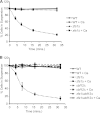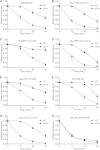Posttranscriptional regulation of cell-cell interaction protein-encoding transcripts by Zfs1p in Schizosaccharomyces pombe
- PMID: 22907753
- PMCID: PMC3457339
- DOI: 10.1128/MCB.00325-12
Posttranscriptional regulation of cell-cell interaction protein-encoding transcripts by Zfs1p in Schizosaccharomyces pombe
Abstract
Members of the tristetraprolin (TTP) family of CCCH tandem zinc finger proteins can bind directly to AU-rich elements in mRNAs and promote transcript deadenylation and decay. The yeast Schizosaccharomyces pombe expresses a single TTP family member, Zfs1p. In this study, we identified probable Zfs1p target mRNAs by comparing transcript levels in wild-type yeast and zfs1Δ mutants, using deep sequencing and microarray approaches. We also used direct RNA sequencing to determine polyadenylation site locations and to confirm the presence of potential Zfs1p target sequences within the target mRNA. These studies identified a set of transcripts containing potential Zfs1p binding sites that accumulated significantly in the zfs1Δ mutants; a subset of these transcripts decayed more slowly in the zfs1Δ mutants and bound directly to Zfs1p in coimmunoprecipitation assays. One apparent direct target encodes the transcription factor Cbf12p, which is known to increase cell-cell adhesion and flocculation when overexpressed. Studies of zfs1Δ cbf12Δ double mutants demonstrated that the increased flocculation seen in zfs1Δ mutants is due, at least in part, to a direct effect on the turnover of cbf12 mRNA. These data suggest that Zfs1p can both directly and indirectly regulate the levels of transcripts involved in cell-cell adhesion in this species.
Figures





References
-
- Beltraminelli N, Murone M, Simanis V. 1999. The S. pombe zfs1 gene is required to prevent septation if mitotic progression is inhibited. J. Cell Sci. 112:3103–3114 - PubMed
-
- Blackshear PJ. 2002. Tristetraprolin and other CCCH tandem zinc-finger proteins in the regulation of mRNA turnover. Biochem. Soc. Trans. 30:945–952 - PubMed
-
- Brewer BY, Malicka J, Blackshear PJ, Wilson GM. 2004. RNA sequence elements required for high affinity binding by the zinc finger domain of tristetraprolin: conformational changes coupled to the bipartite nature of AU-rich mRNA-destabilizing motifs. J. Biol. Chem. 279:27870–27877 - PubMed
-
- Carballo E, Lai WS, Blackshear PJ. 2000. Evidence that tristetraprolin is a physiological regulator of granulocyte-macrophage colony-stimulating factor messenger RNA deadenylation and stability. Blood 95:1891–1899 - PubMed
-
- Carballo E, Lai WS, Blackshear PJ. 1998. Feedback inhibition of macrophage tumor necrosis factor-alpha production by tristetraprolin. Science 281:1001–1005 - PubMed
Publication types
MeSH terms
Substances
Grants and funding
LinkOut - more resources
Full Text Sources
Molecular Biology Databases
